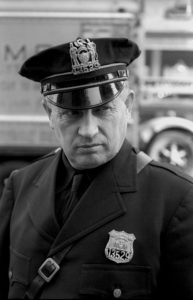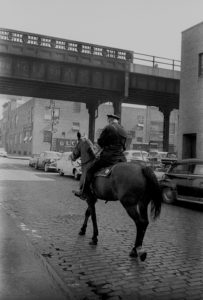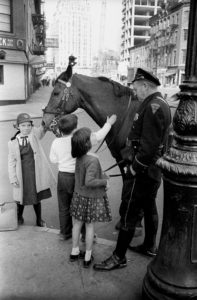THE ROCKEFELLERS – ANNE-MARIE RASMUSSEN
AND HER FORGOTTEN UNCLE – THE COP
(July 1959)

The floodgates didn’t exactly open after Bob Soth’s collapse was spread across two pages of Paris Match. Though Roger Therond now knew who I was, he wasn’t calling Stephane or Slade to put me to work.
Two weeks passed with little recognition of my journalistic coup. I came to the office several times, but I was beginning to feel like I was looking for a handout – magnified by the fact that every time I visited my Match “colleagues” they felt obligated to take me to lunch around the corner, on Madison Avenue, at Mayhews. Of my many meals there what I recall vividly is freelance photographer Charles Bonnay, a former French paratrooper (as were so many Match photographers), ordering three eggs, sunny-side up, then covering the yellow yokes with so much ground pepper they was completely black. But there weren’t any assignments for me. Paul Slade was handling everything and when there was a need for a second cameraman, Charles Bonnay was in position.
When my next opportunity presented itself it was Stephane Groueff who called asking me to come in to the office. Slade was out of town or indisposed and they wanted me to illustrate a possible story for the magazine.
Steven Rockefeller, one of Nelson Rockefeller’s sons, was soon to marry a “commoner.” In what was a near scandal in the Silk Stocking District, twenty-year-old Anne-Marie Rasmussen, a Norwegian “girl,” who’d been working in the kitchen of the Rockefeller town home, had caught the fancy of Steven, and the two youngsters had fallen head over heels in love. Anne-Marie was a strikingly beautiful woman, tall and demure. The daughter of a shop clerk from a small town in Norway, she came to New York a year earlier to learn the English language.
If there was anything that Paris Match loved more than war photography it was wedding photography. Royal wedding were of course always desirable, but rich aristocrats were just as good and an aristocrat marrying a shopkeepers daughter, that was the epitome of Match coverage. The Rockefellers were as close to American royalty as they come. Once every six months, it seemed, the magazine graced a dozen or so pages with full color photographs of some Princess or gorgeous movie star marrying a fat, mustached tycoon; or a twerpy, brightly uniformed, royal son taking vows alongside a tiara-wearing second cousin, once removed.
The Rasmussen-Rockefeller romance and nuptials were made to order for a Match story: “‘Prince Steven finds a scullery maid in the crowd and lifts her out of her ordinary world and into the life of privilege and wealth.” The actual wedding was to take place in Anne-Marie’s small, Norwegian village church, though the Rockefellers were to underwrite the expense, and it would be one swelluva party. Paris Match would be sending several of their garden trampling, cop bribing, socially connected reporters and photographers, to cover the events in Norway and would more than likely come away with the best, secretive, never before seen, snaps of the bride fixing a garter, or nuzzling the groom under an arbor of pink roses.
With all that being planned, where did that leave me, or, rather us, the New York Bureau. We discussed in our meeting that the betrothed couple were still in New York and would more than likely be looking for their own place to live and doing all the things that newlyweds do—though I didn’t have a clue what those things were. After all, I was still living “at home,” just like Steven Rockefeller. So, following them around wouldn’t be easy.
Gaby, the Jewish-Moroccan woman, who worked as Match’s office assistant (and in that regard was my immediate supervisor when I wasn’t taking pictures) read us an article in that day’s NY Daily News and it changed everything. Apparently Anne-Marie Rasmussen had an uncle who was a New York City cop and according to the Daily News, was being completely “snubbed” by the Rockefellers even though he had been the original sponsor who brought Anne-Marie to the United States.
When we investigated further, the story got even better. Uncle Rasmussen (his name was actually Swensen) was a Sergeant in Troop B of the NYPD Mounted Police Unit. We found out where the troop’s stables were located and I went downtown alone to talk to Sergeant Swenson about his situation with his niece, the future Mrs. Rockefeller.
Sergeant Swensen was photogenic and suspicious of the publicity he was about to receive and said that he couldn’t really cooperate with me but there was nothing stopping me from taking his picture while he was out on the street, working his beat. I photographed him preparing his horse, taking him out of the lower Westside stables, then followed him as he rode along his designated “beat” to the meatpacking district. Having never been to Paris I wasn’t aware at how symbolic this was. Les Halles, the midnight wholesale market in the center of Paris was as photogenic as it gets – all the famous Paris street photographers had documented it – one even photographed a bride and groom parading through the blood and grime and fish heads.
I photographed Sgt. Swensen on his horse – a retired thoroughbred, plodding along the wooden crates of vegetables and hanging sides of beef. But still, I sensed I wasn’t getting what we needed. I tried to interview him but he wasn’t very talkative–and besides, without permission from the NYPD Information office, he’d be taking a chance talking on the job. He said only that he’d put up the money to have Anne-Marie come to America, he’d put her up in his home for her first few weeks until she found work. He was disappointed that once she became engaged to a Rockefeller her attitude towards the cop and his family changed. He hadn’t expected it, but he fully understood. Anne-Marie was now breathing rarified air and he would merely only qualify as a palace guard.

A week later, during the daily telephone call from Roger Therond he mentioned my pictures of the horse cop. When Stephane emerged from his narrow back office, wearing his impeccably tailored, double-vented, gray suit, he said hello to me, then, “Therond liked your photos of the cop and his horse. They’re printing two pages with the wedding story.” Then Stephane smiled. “Félicitations, Chuck. You are now officially one of us.”
And Anni Tchaprachikoff, Stephane’s cousin from Sofia who managed the office, added with her thick accent, “Bienvenue, Chuck.” They were trying to teach me French, with their Bulgarian accents.
True to form, Paris Match covered the Norwegian Rockefeller wedding in true royal fashion. Lots of color pictures, lots of men in black tie and women in hats and long gloves. My photographs added the necessary Match touch: the poignancy of a man forgotten: Sergeant Swensen; still in New York. Alone with his horse. Therond knew what he was doing.


Leave a Reply